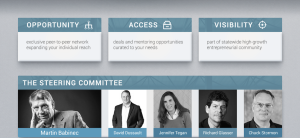Overcome seed investor exit bias with vision and passion
As an active seed investor with my UpVentures, it’s not unusual for me to be weighing odds of investing in one company with some plausible acquirer targets on the horizon, versus another startup with a more speculative moon shot based on a large, but totally unproven, market opportunity.
This dynamic plays to entrepreneurs too. Wouldn’t a more likely pay day come in a space where others have shown some traction, ahead of being out there on the “bleeding” edge because you’re pioneering something that almost no one else sees yet?
There is no absolute here. Though as a seed stage investor, it is probably a good idea to have a portfolio with a mix of these two opportunity paths.
Investors can under appreciate market timing
Being ahead of the curve in a new and unfamiliar industry raises seed investor uncertainty about where the exit paths will be. This prompts a subtle bias for us to instead focus attention on opportunities that seem to have nearer term possibilities for liquidity.
But as IdeaLab founder Bill Gross recaps in this video reviewing data from 110+ companies he had a hand in, his search for causality in the factors of idea, team, business model, funding and timing (five classic early stage investor criteria) shows evidence that market timing had more to do with startup success than any of the other key criteria we seed investors rely upon.
Even one better is the wisdom of Paul Graham and his insights that come from decades of seed stage investing and running Y Combinator.
While multiple Paul Graham essays touch on this theme of market timing, one of my favorites is Black Swan Farming – he nails this seed investor bias against new models and markets by sharing logic behind his thinking why he felt Facebook was a lame seed investment opportunity when he first heard of it.
Biggest opportunities powered by multiple macro forces
While startups generally have some kind of societal, market or technological trend underlying their plausibility for being an investable growth business, if you parse through any list of $1B+ exits, you’ll see the big winners enjoyed a confluence of multiple macro trends that drove growth for an extended period.
 My appreciation for this factor of multiple trend convergence began as it was probably the biggest reason prompting launch of my own startup journey in founding TriNet in 1988.
My appreciation for this factor of multiple trend convergence began as it was probably the biggest reason prompting launch of my own startup journey in founding TriNet in 1988.
While very much a rookie entrepreneur then, I was more than a little passionate about how certain trends were both irreversible and directly related to powering our business model behind outsourced HR services including:
- Increasing government regulations burdening employers
- Shift in employment landscape from large companies to small
- Smaller companies needing benefits to compete for talent (previously the domain only of big companies)
- Technology adoption driving both speed of business (narrowing core competency that would in turn drive outsourcing) plus add new capabilities to enable efficiency in service delivery across a large number of smaller company customers.
As obvious as these trends might seem today, the late 1980’s was a different world and even venture investors couldn’t warm up to our opportunity since they didn’t then appreciate how our perceived pure service business could be sufficiently technology enabled to scale and leverage these converging trends as fully as TriNet proved to do.
Winning entrepreneurs articulate vision with passion
Vision and passion are important for any startup CEO. But if you’re forging new paths in unchartered models, you’ll be hard pressed to raise seed funding without a founder CEO getting across both these qualities.
Take the time to unpack specifics behind your supporting macro trends. Cite independent sources with data that supports your thesis. Tying multiple trends to defined elements of your business model and execution strategy boosts credibility in your vision.
But even those actions are not enough to sway seed investor interest if there isn’t a clear sense of deep personal passion on why this means so much to you.
Passion comes through when investors become convinced about the entrepreneur’s emotional commitment to the “why me” behind the problem the venture is solving. Our senses pick up the cues for this emotional commitment probably more so by how you articulate, than the logic supporting your argument.
A deep, passionate commitment is essential to overcoming the many obstacles ahead, including attracting the right team members who you’ll be asking to take their own risks in joining a team with an unproven model and/or industry.
Entrepreneurs who get seed investor attention are the ones whose vision and passion are so ingrained in their persona that they clearly differentiate from the crowd of their startup peers.
So don’t fear being “over the top” in getting across your passion and commitment. How you message that emotional commitment, coupled with a clear vision that ties specific trends to your model is what we’re looking for.
Winning investor hearts, along with our minds, is the combination that unlocks wallets to speculate with even greater risk than the semi plausible exit strategy we’re weighing you against as our investment alternative.


